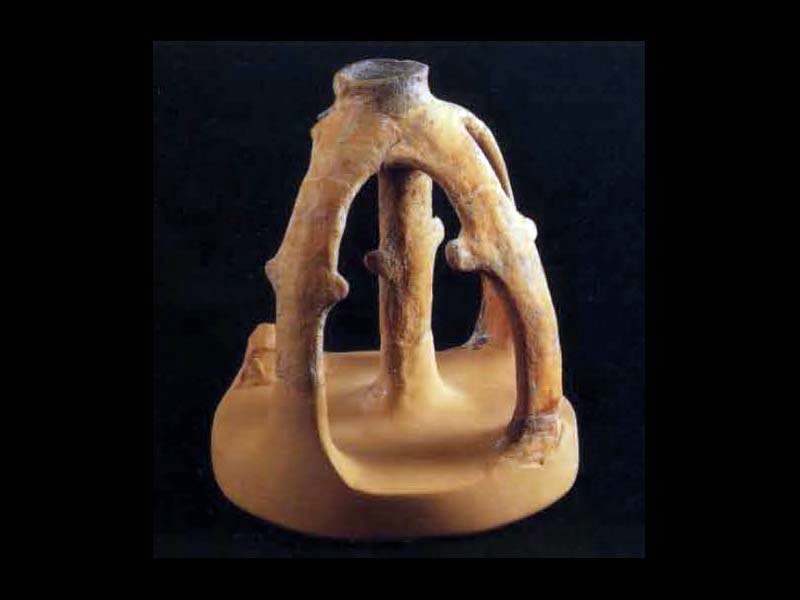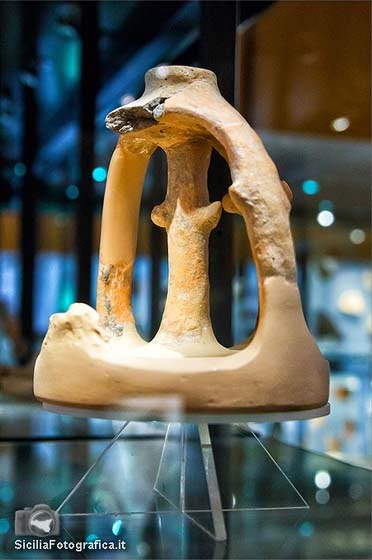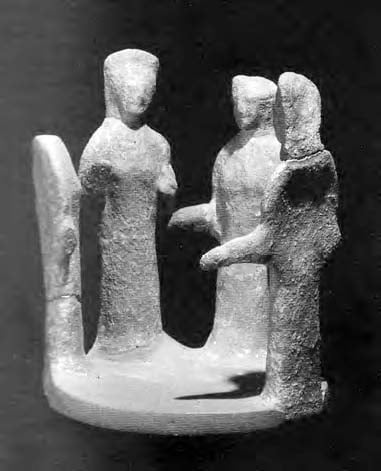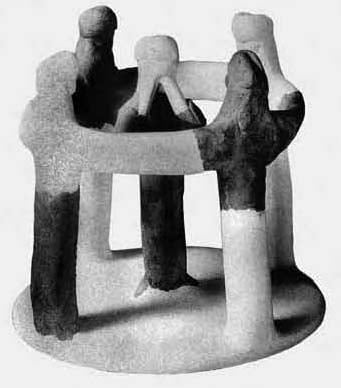In the heights above Palma di Montechiaro, in the area of Monte Grande, several structures have been identified which seem to form a monumental Castelluccian sanctuary dating back to a middle phase of the Ancient Sicilian Bronze Age and frequented up to the Middle Bronze Age.
The area is rich in extraordinarily pure sulfur mines (exploited since the Ancient Bronze Age), which together with a rich concentration of sulphurous water springs have made this place a cultic reference point for the entire surrounding area of the district between the Platani rivers and Palma.
Here was found one of what appears to be among the first representations of a dance in a circle around a divine entity, represented in the so-called 'clay model of a small temple-hut', found in a Sicilian prehistoric site which stands out for the discovery of numerous votive offerings linked to ritual activities including, probably, funeral banquets, collective ritual meals and sacred ceremonies which seem to have taken place periodically and involving a large number of participants.
Indeed, we find zoomorphic figurines, clay horns and phalluses, stone hatchets, terracotta statuettes, table ceramics and other objects not related to domestic contexts; among these objects brought to light there are some of exceptional symbolic and religious value: we want to dwell in particular on the "hut-temple", an ex-voto found in the sanctuary which appears to be linked to the cultic activity of the complex.
It would be one of the very first examples of clay groups of dancing figures in a circle, a votive substitute for choroi humans, which then spread in the Archaic period both in the West and in mainland Greece; compared to the much better known bronze groups and vase representations, much less attention has been paid to clay dance models, also due to the discovery – in most cases – of only fragmentary parts which make identification and reconstruction difficult.
In the archaic age "the dancing groups appear extremely simplified in structure and ornamental details" (Albertocchi). The small size of the votive pottery and the fragility of the compositions of the archaic age, made by hand and not on the wheel, probably also caused the simplification in the rendering of the movement of the subjects, often limited to the position of the open arms, symbolizing the bond between dancers/ dancers holding hands.
In the exhibit examined here, the anthropomorphic figures are in fact extremely stylized, and do not appear to have a sexual characterization; however, the comparison with other examples of the Aegean area, characterized in almost all specimens by the presence of a polos (female headgear) or a stephane (crown usually intertwined with plant elements) on the head of the anthropomorphic figures, suggests female figures.
This hypothesis is also supported by the discovery, on site, of numerous objects for weaving (loom weights, oscillates and votive clay spindles), which show how the manufacture of fabrics was one of the privileged activities that took place in the sanctuary. The clay horns and phalluses and the terracotta statuettes would also be linked to the female sphere, suggesting that seasonal rituals for fertility and procreation could take place in the place.
The circular dance depicted, in a sacred space around a divinity or a human figure that represents its manifestation, may have had a religious value in relation to the occasions that were to take place in particular moments of the year that were significant for the entire community.
The performance of ritual dances would also explain the discovery of numerous shells used as necklace pendants, suitable for sonorously marking the rhythmic movement on collective occasions and for accompanying the percussive action of celebrations.
Dance, as an expressive tool proper to cult practices between the Bronze Age and the Iron Age, is depicted through similar models in various places in the Mediterranean: in Crete, in particular during the celebrations of the rites of passage into the adult; in Cyprus; in the Corinthian area; in the Peloponnese; in Attica and Boeotia. As far as the West is concerned, we find the same model – but in historical times – in the area of the Heraion del Sele (Paestum) and in S. Anna di Cutro (Crotone).
The presence of this model can tell aspects of the ceremonial system of the context of discovery, which help to understand the ritual function of dance in the ancient Mediterranean as early as the second millennium BC "Through the repeated and coordinated execution of sequences of movements within a precise ritual context, dance, as a movement of the body in a symbolic form, incorporated the communication of beliefs and behaviors, becoming a means of knowledge of the social norms accepted and shared by the community. According to Gaudenzio Ragazzi, dance made possible the 'sensation' of 'agreement' and belonging that was created among all the dancers, as well as a social cohesion that was difficult to find in other social events" (Bellia), and which contributed strongly, alongside to the sacred banquets of the community that took place here, to the mechanisms of community creation and cohesion.




Historical notes
The study of the model went through various interpretative phases, starting from the first analyzes carried out by Castellana in the late 90s. It was initially identified as a representation of the sacred structure of a small temple with four lateral posts; later it was proposed to consider it as the representation of an epiphany scene (a hypothesis that can be reconciled with the first interpretation); finally, the lateral protuberances of the so-called "poles" have been interpreted, in comparison with other depictions of contemporary dancers from the Mediterranean area (Albertocchi), as stumps of outstretched arms.
Today we therefore recognize in the model the representation of a circular dance of four anthropomorphic figures around a central idol in the ritual context of a place of worship.
Several finds found in Monte Grande also testify to an attendance with the Aegean area: among these, an agate talisman pearl with spiral and meander decoration, various ceramics, globular jars of Cypriot origin and more.
The archaeological discoveries seem to give historical substance to the mythological saga of Minos, Daedalus and the Sican king Kokalos, testifying to the ancient contacts of the Sicans with the Aegean world and with the Anatolian-Cypriot environment from the end of the XNUMXth century. to the thirteenth century. B.C
Few other examples of this type of representations have been found in Sicily, relating to this historical period. However, there is a lively later literary tradition regarding the link between festive celebrations in honor of female divinities with dance and music: they concern the cult of Artemis (especially in the Syracuse area), the cult of the Nymphs, and, for the archaic era and classic in the Geloo-Agrigento area, the thesmophoric cult linked to Demeter: the dedications of the dancing groups were intended for Demetrian and Koreic areas.
In this particular context, the clay groups have the symbolic function of evoking gods choroi of young girls on the border between childhood and maturity, who require the protection of female divinities in charge of the transition phases, in the most delicate moments of the existential path of female life. In fact, the dance refers to the fundamental moments in the life of the girls and to the initiation rites linked to them: the girls, by dancing, express their status liminate between the role of parthenos and gyné, placing himself under divine protection, in an effective symbolic evocation of the choroi mythical female Nymphs, guardian divinities of thresholds and passages. In Sicily the female divinities of reference for the initiatory choirs will be - in addition to the Nymphs - Artemis as protector of the preparation for the wedding and childbirth; Kore, in her paradigmatic role of initiand and bride-girl, and in her relationship with Demeter and the thesmophoric rites.
CARD
LATEST PUBLISHED TEXTS
VISIT THE FACTSHEETS BY OBJECT

